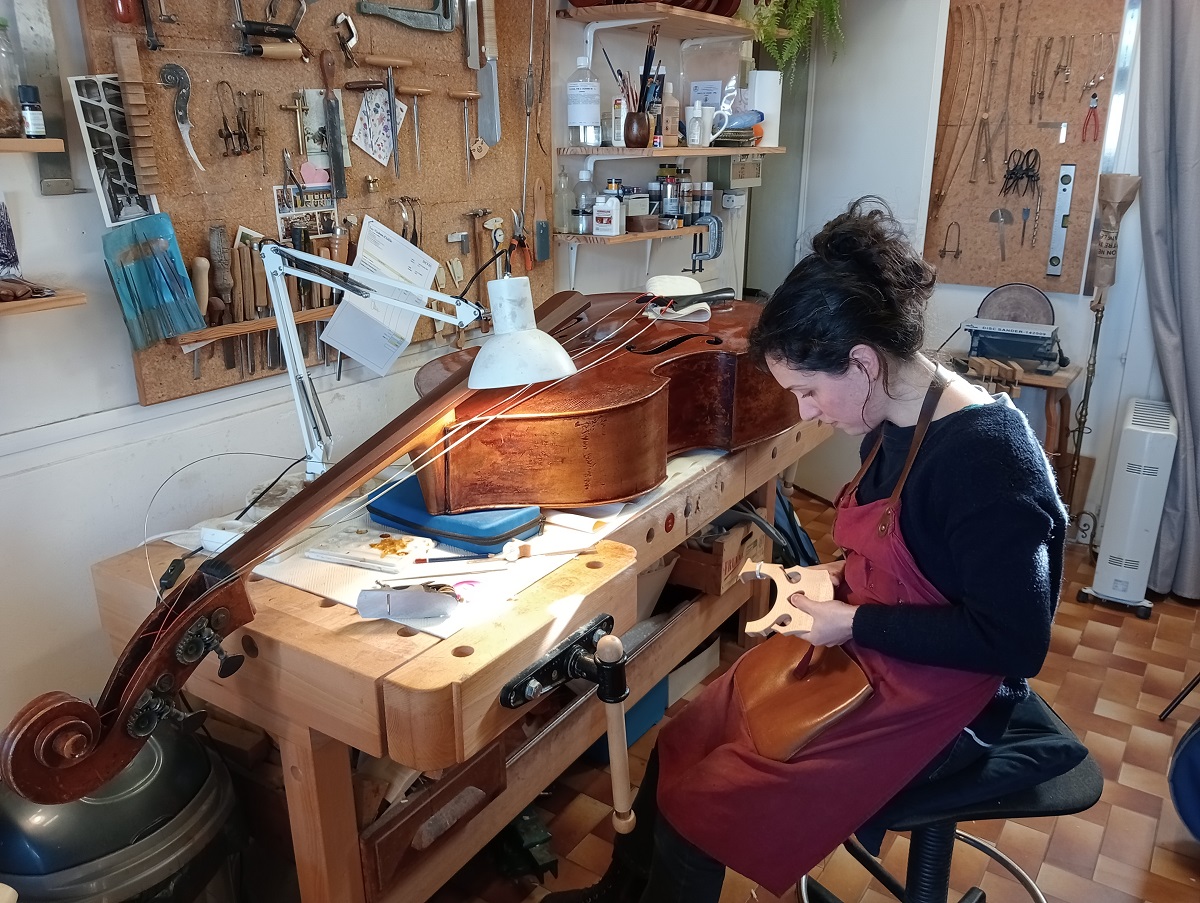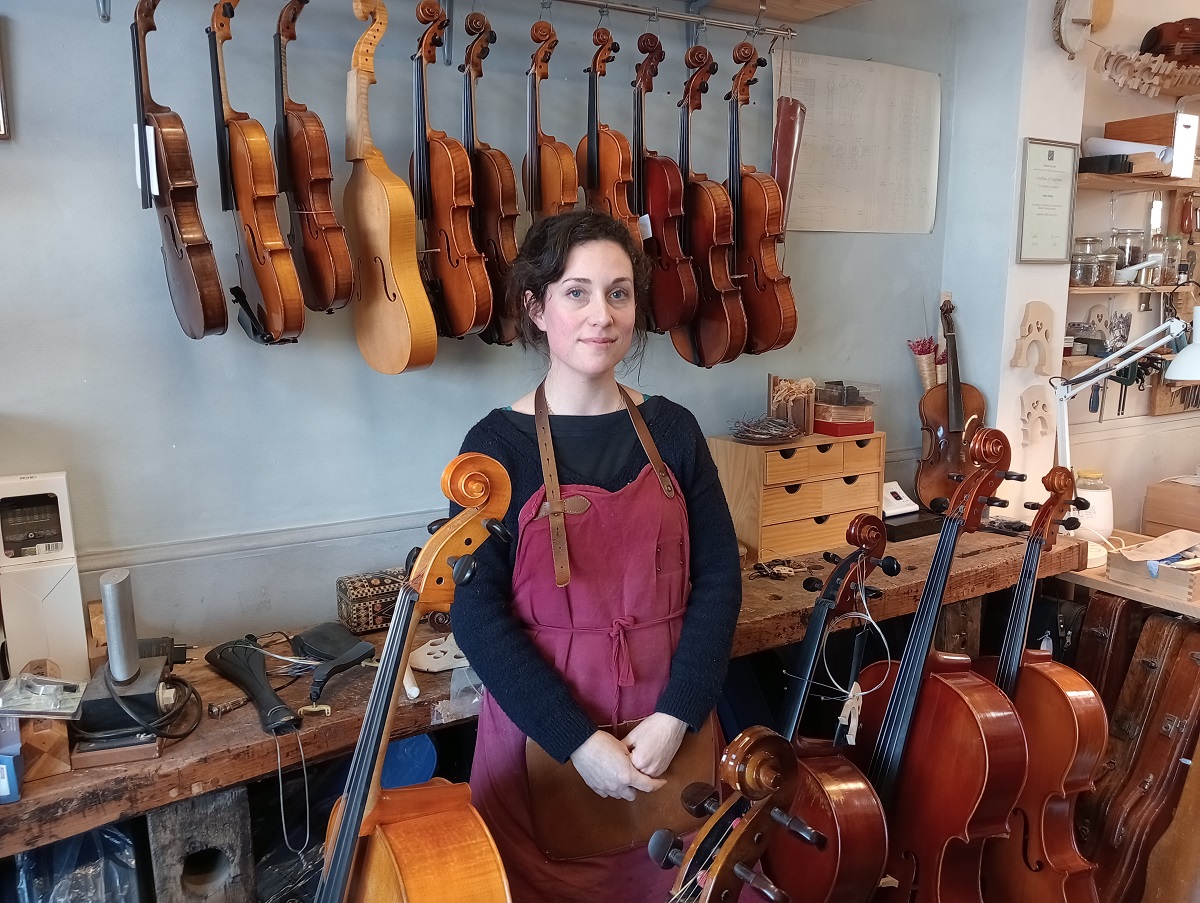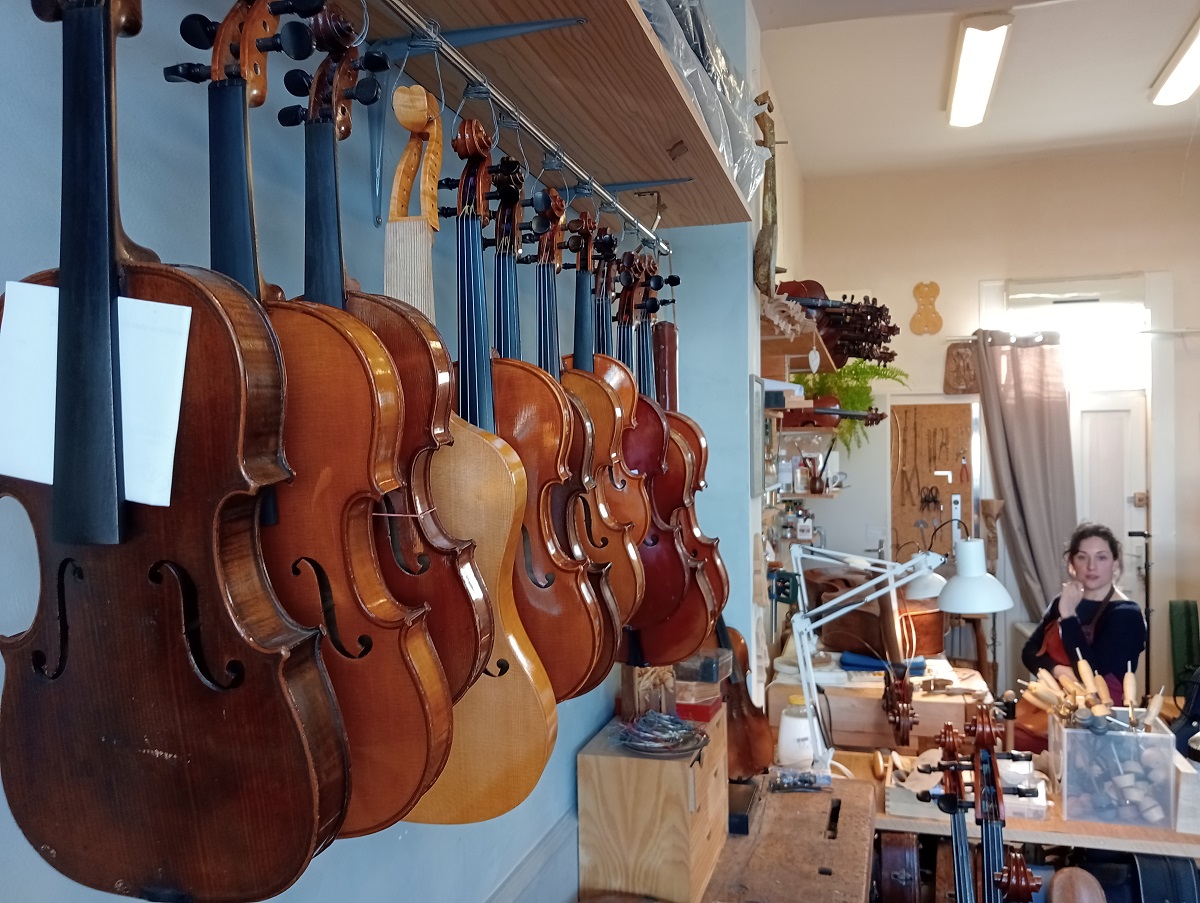Saumur. Meeting: Adele Debias makes scrolls in her Saumur workshop

On the Place de la République in Saumur, a small boy, about ten years old, walks proudly towards the monumental Théâtre du Dôme. On his back, a small triangular case, a view holder in his hand. From the floor of the building, some crystalline notes rise up. A small workshop on the Quai Mayaud, a few steps from this lovely musical show. The sign says “Les Violins d’Adele”. It’s hard to go wrong as the window displays countless wooden scrolls. A man of a certain age arrives by bike, Saumur obliges. He enters the shop and emerges moments later with a magnificent violin, shiny brown. Without the case, he puts it in a small backpack, what some further south call a “pocket,” then walks off with a few pedal strokes. We in turn open the workshop door. First impression, smell. That wood, which has just been cut. “You’re lucky, there are days when glue made from animal bones or varnish made from mealybug feces and linseed oil make the smell less pleasant”, says Adèle Debias, a luthier who has occupied this position for 7 years now. Inside, violins and violas adorn the walls, suspended by their captivating, rotating heads. On the floor, cellos, similar shape, but more impressive size. And on the workbench, a huge grandmother: “It’s an 1850s double bass that a customer gave me for restoration. He got it from Saumur Music School. It had been stored in poor condition for a long time. I had to completely remove the table and open the instrument to strengthen the internal structure”, explains Adèle. A real open heart operation and a project lasting about 6 months to bring new life and new vibrations to this woman with huge hips.
From the bow to the plane
 Adele Debias’s passion for the violin began very early. In her native Alsace, she learned piano and viola at age 7. “In fact, I quickly encountered a luthier who regularly maintained my instrument. This was my first encounter with the profession. You really had to practice the instrument to meet him and find his activity because he was a bit hidden, in a small village, in a workshop that didn’t have a storefront”. Over time, Adele could not fully develop just by practicing the viola. “I was missing something, maybe the manual side”. She then decided to learn to make violins, which combined her desire for manual work and her passion for music and the violin in particular. “This luthier was not encouraging. He didn’t want to take me on apprenticeships or internships and told me to just leave, it was too hard. » She did not give up and after her graduation, tried to enroll on file to learn violin making in two schools in Europe. One at Mirecourt in the Vosges – fortunately close to home – and the other in England. She would not be housed in France and would eventually move across the Channel to study. She trained in quartet violin making (violin, viola, cello and double bass) for 4 years and graduated in 2011. “When you finish your studies, you are released into nature and you get to explore widely”. Adèle then sends applications across Europe, to Sweden, Belgium, England and France. She finally got positive feedback from a luthier… in Le Mans! “A stroke of luck, especially since I was taken from September following my studies, and places in the workshop are very expensive. It is a specialized profession and you have to be ready to go where the work is. » She stayed there for 5 years.
Adele Debias’s passion for the violin began very early. In her native Alsace, she learned piano and viola at age 7. “In fact, I quickly encountered a luthier who regularly maintained my instrument. This was my first encounter with the profession. You really had to practice the instrument to meet him and find his activity because he was a bit hidden, in a small village, in a workshop that didn’t have a storefront”. Over time, Adele could not fully develop just by practicing the viola. “I was missing something, maybe the manual side”. She then decided to learn to make violins, which combined her desire for manual work and her passion for music and the violin in particular. “This luthier was not encouraging. He didn’t want to take me on apprenticeships or internships and told me to just leave, it was too hard. » She did not give up and after her graduation, tried to enroll on file to learn violin making in two schools in Europe. One at Mirecourt in the Vosges – fortunately close to home – and the other in England. She would not be housed in France and would eventually move across the Channel to study. She trained in quartet violin making (violin, viola, cello and double bass) for 4 years and graduated in 2011. “When you finish your studies, you are released into nature and you get to explore widely”. Adèle then sends applications across Europe, to Sweden, Belgium, England and France. She finally got positive feedback from a luthier… in Le Mans! “A stroke of luck, especially since I was taken from September following my studies, and places in the workshop are very expensive. It is a specialized profession and you have to be ready to go where the work is. » She stayed there for 5 years.
Violin making in Saumur
 Then came the desire to settle down, set up his own workshop. “I came to Saumur, I found the region very beautiful and picturesque. To settle down, we often look where the orchestra is, and we move closer to the big cities. That’s not what I did! I chose Saumur. It took longer to settle in and get to know myself. But I have no direct competition! And today everything is going well and I manage to have enough turnover in my clients so that I don’t have to worry. First customers return. » Today, its customers are very wide: “People from Paris who have passed through and entrusted me with their equipment. They find it more practical and easy here. I’m cheap too! I also have foreign clients, including an American who has a home in Candace. It must be said that Saumur has many secondary houses. I spread throughout the region usually in Cholet, Bressuer, Thouars or even Poitiers where there is only one luthier. » Professionals as well as amateurs and hobbyists who want to bring an instrument to life. “The hardest part is understanding what the customer wants. Restoration may take several months. No need to rush, study the problem carefully. There is no standard solution. You have to observe and listen. Sometimes it’s a real crush when a customer comes back to try out his instrument, sometimes I’ve had tears in my eyes, especially when he plays well.she explains. “I especially enjoy working with children. We see them start and develop over the years.
Then came the desire to settle down, set up his own workshop. “I came to Saumur, I found the region very beautiful and picturesque. To settle down, we often look where the orchestra is, and we move closer to the big cities. That’s not what I did! I chose Saumur. It took longer to settle in and get to know myself. But I have no direct competition! And today everything is going well and I manage to have enough turnover in my clients so that I don’t have to worry. First customers return. » Today, its customers are very wide: “People from Paris who have passed through and entrusted me with their equipment. They find it more practical and easy here. I’m cheap too! I also have foreign clients, including an American who has a home in Candace. It must be said that Saumur has many secondary houses. I spread throughout the region usually in Cholet, Bressuer, Thouars or even Poitiers where there is only one luthier. » Professionals as well as amateurs and hobbyists who want to bring an instrument to life. “The hardest part is understanding what the customer wants. Restoration may take several months. No need to rush, study the problem carefully. There is no standard solution. You have to observe and listen. Sometimes it’s a real crush when a customer comes back to try out his instrument, sometimes I’ve had tears in my eyes, especially when he plays well.she explains. “I especially enjoy working with children. We see them start and develop over the years.  With a music school, there is a strong demand for rentals. Instead of importing violins from China, I chose to buy old violins and restore them to create a collection. » It offers tuning, maintenance and restoration services as well as the manufacture of new violins. New violins certainly, but with looks and architecture almost unchanged over the centuries: “It is true that the violin has a very classical image. But the model exists and works very well as such. Its construction is very well thought out and studied. In construction, it’s the details that make the difference, the beauty of the top, the woods used, the varnish, the way the sides are bent (editor’s note: violin sides). Players are also usually very classical and look for very specific sounds. We must adapt to the demand. » From the board she found, to the violin ready to be played, it took 300 hours of work, and double that for the cello. Clearly, the relationship of these tools to time is specific. Their Project for 2024: “Start playing the violin seriously!” »
With a music school, there is a strong demand for rentals. Instead of importing violins from China, I chose to buy old violins and restore them to create a collection. » It offers tuning, maintenance and restoration services as well as the manufacture of new violins. New violins certainly, but with looks and architecture almost unchanged over the centuries: “It is true that the violin has a very classical image. But the model exists and works very well as such. Its construction is very well thought out and studied. In construction, it’s the details that make the difference, the beauty of the top, the woods used, the varnish, the way the sides are bent (editor’s note: violin sides). Players are also usually very classical and look for very specific sounds. We must adapt to the demand. » From the board she found, to the violin ready to be played, it took 300 hours of work, and double that for the cello. Clearly, the relationship of these tools to time is specific. Their Project for 2024: “Start playing the violin seriously!” »





